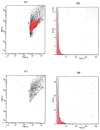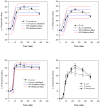In Vitro Simulated Hemoperfusion on Seraph®-100 as a Promising Strategy to Counteract Sepsis
- PMID: 38540188
- PMCID: PMC10967825
- DOI: 10.3390/biomedicines12030575
In Vitro Simulated Hemoperfusion on Seraph®-100 as a Promising Strategy to Counteract Sepsis
Abstract
Blood purification represents a treatment option for sepsis, improving inflammation and the hyper-activated immune system. This study investigates the binding efficacy of Seraph®-100 against 108 CFU/mL of Staphylococcus aureus (S. aureus), Pseudomonas aeruginosa (P. aeruginosa), and Escherichia coli (E. coli) during a simulated hemoperfusion treatment. The fluorescence-activated cell sorting (FACS) technique was used to evaluate the bacteria reduction, whereas kinetic analysis and cultures revealed bacterial detection and counting at established time points. At the end of the experiment, the filter was cut at three different levels, obtaining suspensions for cultures and scanning electron microscopy (SEM) analyses. The FACS technique revealed a 78.77% reduction of the total bacterial load at the end of the treatment, with maximum filter sequestration occurring in the first 30 min of the treatment. Non-linear regression analysis of kinetic experiments (T0-240 min) highlighted a lower growth rate of S. aureus than the other two Gram bacteria, demonstrating a greater affinity without influencing a reduction rate of 99% for all three bacteria. The analyses of the suspension aliquots of the filter sections confirmed these data, revealing 1 × 108 CFU/mL, equal to the initial bacterial charge. Furthermore, the filter head adsorbed approximately 50% of bacteria, whereas the remaining amount was equally distributed between the body and the tail, as corroborated by SEM analysis. In conclusion, Seraph®-100 adsorbed 108 CFU/mL of S. aureus, E. coli, and P. aeruginosa during an in vitro simulated hemoperfusion session.
Keywords: Seraph®-100; acute kidney injury; adsorption; renal replacement therapy; sepsis.
Conflict of interest statement
The authors declare no conflicts of interest.
Figures






Similar articles
-
Hemoperfusion with Seraph-100 in septic patients removes pathogens and improves clinical outcomes.Sci Rep. 2025 May 21;15(1):17626. doi: 10.1038/s41598-025-01280-z. Sci Rep. 2025. PMID: 40399373 Free PMC article.
-
Staphylococcus aureus binding to Seraph® 100 Microbind® Affinity Filter: Effects of surface protein expression and treatment duration.PLoS One. 2023 Mar 17;18(3):e0283304. doi: 10.1371/journal.pone.0283304. eCollection 2023. PLoS One. 2023. PMID: 36930680 Free PMC article.
-
Safety and efficacy of the Seraph® 100 Microbind® Affinity Blood Filter to remove bacteria from the blood stream: results of the first in human study.Crit Care. 2022 Jun 17;26(1):181. doi: 10.1186/s13054-022-04044-7. Crit Care. 2022. PMID: 35715801 Free PMC article. Clinical Trial.
-
[Extracorporeal removal of pathogens using a biomimetic adsorber-A new treatment strategy for the intensive care unit : Seraph® 100 Microbind® Affinity Blood Filter and its fields of application].Med Klin Intensivmed Notfmed. 2025 May;120(4):290-299. doi: 10.1007/s00063-024-01153-9. Epub 2024 Jul 10. Med Klin Intensivmed Notfmed. 2025. PMID: 38981926 Review. German.
-
[Hemoperfusion in anesthesia and intensive care medicine: benefits, risks, and evidence for different systems].Anaesthesiologie. 2023 Dec;72(12):843-851. doi: 10.1007/s00101-023-01341-w. Epub 2023 Sep 14. Anaesthesiologie. 2023. PMID: 37707564 Review. German.
Cited by
-
Hemoperfusion with Seraph-100 in septic patients removes pathogens and improves clinical outcomes.Sci Rep. 2025 May 21;15(1):17626. doi: 10.1038/s41598-025-01280-z. Sci Rep. 2025. PMID: 40399373 Free PMC article.
-
Molecular Biomarkers and More Efficient Therapies for Sepsis.Biomedicines. 2025 Feb 14;13(2):468. doi: 10.3390/biomedicines13020468. Biomedicines. 2025. PMID: 40002880 Free PMC article.
-
The Seraph 100® Microbind Affinity Blood Filter Does Not Alter Levels of Circulating or Mucosal Antibodies in Critical COVID-19 Patients.Antibodies (Basel). 2024 Aug 6;13(3):65. doi: 10.3390/antib13030065. Antibodies (Basel). 2024. PMID: 39189236 Free PMC article.
-
Selective removal of proteins and microvesicles ex vivo from blood of pancreatic cancer patients using bioengineered adsorption filters.Cancer Lett. 2025 Apr 1;614:217546. doi: 10.1016/j.canlet.2025.217546. Epub 2025 Feb 12. Cancer Lett. 2025. PMID: 39952600
-
Surgical Aortic Valve Replacement and Renal Dysfunction: From Acute Kidney Injury to Chronic Disease.J Clin Med. 2024 May 16;13(10):2933. doi: 10.3390/jcm13102933. J Clin Med. 2024. PMID: 38792474 Free PMC article.
References
-
- Nordio M., Reboldi G., Di Napoli A., Quintaliani G., Alberici F., Postorino M., Aucella F., Messa P., Brunori G. Italian Society of Nephrology COVID-19 Research Group: Risk factors and action thresholds for the novel coronavirus pandemic. Insights from the Italian Society of Nephrology COVID-19 Survey. J. Nephrol. 2021;34:325–335. doi: 10.1007/s40620-020-00946-3. - DOI - PMC - PubMed
-
- Rudd K.E., Johnson S.C., Agesa K.M., Shackelford K.A., Tsoi D., Kievlan D.R., Colombara D.V., Ikuta K.S., Kissoon N., Finfer S., et al. Global, regional, and national sepsis incidence and mortality, 1990–2017: Analysis for the Global Burden of Disease Study. Lancet. 2020;395:200–211. doi: 10.1016/S0140-6736(19)32989-7. - DOI - PMC - PubMed
-
- Nelson R.E., Hatfield K.M., Wolford H., Samore M.H., Scott R.D., Reddy S.C., Olubajo B., Paul P., Jernigan J.A., Baggs J. National Estimates of Healthcare Costs Associated with Multidrug-Resistant Bacterial Infections Among Hospitalized Patients in the United States. Clin. Infect. Dis. 2021;72:S17–S26. doi: 10.1093/cid/ciaa1581. - DOI - PMC - PubMed
LinkOut - more resources
Full Text Sources
Molecular Biology Databases

